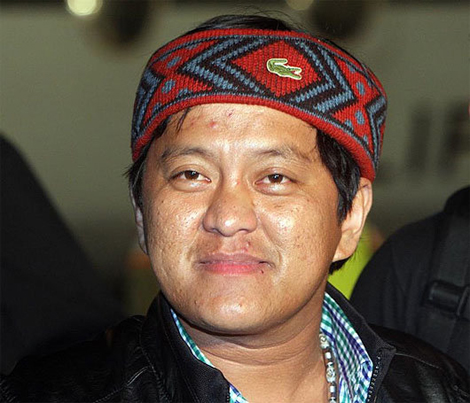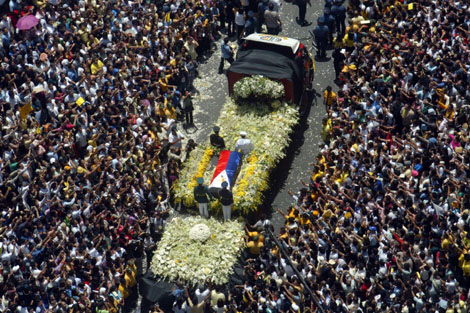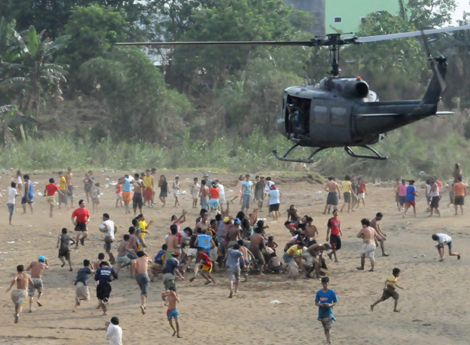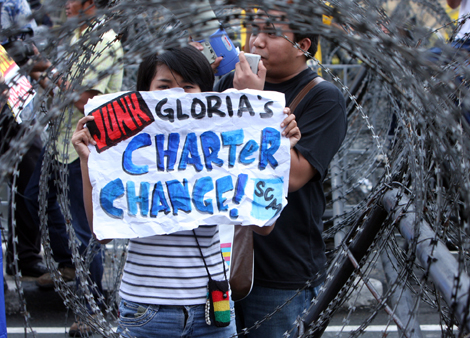The year 2009 shocked the public. A novel virus swept the world into a health-conscious frenzy and caused at least 11,000 deaths globally. The Philippines’ icon of democracy passed away, uniting the country one more time and suddenly ushering her son into the presidential race. A brutal massacre enraged the Filipinos so much that many of them did not seem to mind the declaration of the dreaded martial law for the first time since the 1986 ouster of the dictator Ferdinand Marcos. 2009 was the year of the unfamiliar, the unprecedented, the historic.

Datu Unsay Mayor Andal Ampatuan Jr., the primary suspect in the gruesome massacre of 57 people in Ampatuan town, smiles after he turns himself over to authorities for investigation. Danny Pata
In the annals of political violence in the Philippines, the November 23 massacre in Ampatuan, Maguindanao is unparalleled in its ruthlessness. On a Monday morning, Buluan Vice Mayor Toto Mangudadatu sent his wife, accompanied by female clan members and lawyers, to file his certificate of candidacy in Shariff Aguak on his behalf. Around 30 local journalists covered the unprecedented gubernatorial bid, which did not sit well with the rival
Ampatuan clan that has long lorded over the province and is notorious for running a large private army. On the road going to the Comelec office, at least 161 armed men intercepted the convoy and led the hapless civilians to a hillside, where they were brutally killed. Several witnesses have said Datu Unsay
Mayor Andal Ampatuan Jr. was at the massacre scene, firing at the victims and making sure they were dead. Andal Jr. and several members of the Ampatuan clan are facing multiple murder charges for the
mass slaughter of 57 people in the worst election-related violence in the country.

Thousands of people show up on the streets to bid farewell to the country's icon of democracy. Voltaire Domingo
August was the month the country turned yellow. After more than a year of battling colon cancer, former
President Corazon Aquino passed away on August 1. Her death saw the outpouring of support from Filipinos, who turned out in droves to pay their last respects to the
woman who championed democracy after the two-decade tyrannical rule of Ferdinand Marcos. Her wake drew high-profile figures from the international community, who were inspired by the woman in the yellow dress. The transfer of her casket from a school stadium in Quezon City to the Manila Cathedral – a route that traversed major points in Metro Manila – took five hours. Her
funeral cortege lasted more than eight hours as hundreds of thousands of supporters converged on rain-soaked streets, chanting “Cory, Cory!" and showering confetti on her flag-draped casket. Mrs. Aquino’s funeral is considered the public’s biggest sendoff since her husband Ninoy was laid to rest in August 1983.

Residents of Rizal province scamper for relief goods being distributed by the Philippine military. AP
Tropical storm Ondoy (Ketsana) dumped more than a month’s worth of rain in just 12 hours, triggering the
worst flooding to hit the Philippine capital and neighboring provinces in more than 40 years. Barely had the country recovered when typhoon Pepeng (Parma) pummeled northern Luzon a week later. The twin calamites left a trail of destruction – hundreds were killed, millions were displaced, and an estimated $4.4 billion worth of damage was reported. But the extent of devastation became more evident from images of flood-inundated and mud-covered homes, people wading in knee- to chest-deep floods, and throngs of
people desperately scrambling for food. Despite the grim situation – four subsequent storms hit the country within the next month – the disasters saw the
heroism of Filipinos and sparked the spirit of volunteerism in many places.
A(H1N1) flu As it was new and unfamiliar, "swine flu" became one of the most feared diseases in 2009 despite its relatively mild nature. On June 11, the World Health Organization declared a
swine flu pandemic — the first global flu epidemic in 41 years — as infections rose in the United States, Europe, Australia, South America and other places. Countries all over the
world scrambled to detect cases of Influenza A(H1N1) infection, and the Philippines was no exception. When the
first Asian fatality turned out to be a 49-year-old Filipina who had a pre-existing heart disease, stores ran out of face masks and rubbing alcohol as the public went panic buying to protect themselves from A(H1N1) infection. The virus did not die down, but the panic over its spread eventually ceased as public knowledge about the disease increased.
Election fever A month after Mrs. Aquino succumbed to colon cancer, Liberal Party president Senator Mar Roxas announced that he was dropping his presidential ambitions to give way to her only son Senator Noynoy Aquino, who was asked by several groups to follow his mother’s footsteps.
Noynoy eventually heeded the clamor, joining other presidential aspirants such as Senator Manuel Villar Jr. and former president Joseph
Estrada, who will again run for president despite legal questions. Meanwhile, Senator Francis Escudero announced that he would not be running for any post at all, despite his relatively high survey ratings early on. The political landscape became more interesting when President Arroyo finally ended speculation over her political plans and declared that she will seek a
House seat for Pampanga's second district once she steps down in 2010.
Martial law in Maguindanao Filipinos swore "never again to martial law" when they ousted Ferdinand Marcos in 1986, and many have since trooped to the streets over the slightest hint of possible authoritarian rule. Interestingly enough, Mrs.
Arroyo's declaration of martial law in Maguindanao following the November 23 massacre in the province was not met with massive protests, although several political personalities slammed
Proclamation No. 1959 as an unnecessary show of force. The declaration prompted the two chambers of Congress to convene into a joint session, the first in history, to decide whether they would revoke the edict. However, the Senate and the House of Representatives never got to vote on the matter, as Mrs.
Arroyo lifted martial law eight days after the proclamation.

A student holds a placard condemning Charter change during a lightning rally in Mendiola. Danny Pata
On June 2, majority of the members of the House of Representatives did what previous Congresses have failed to do: it approved a charter change measure,
House Resolution 1109, which called on Congress to convene into a constituent assembly that would amend the 1987 Constitution. Many Filipinos are averse to the idea of amending the Constitution under the Arroyo administration, the bad memories from the Marcos era still fresh in their minds. Critics slammed Mrs. Arroyo’s manipulation of the
lower house, which "railroaded" the resolution’s approval by cutting short the interpellation of opposition lawmakers, and
various sectors joined huge protests condemning the move. HR 1109 has been gathering dust in the House, as the Senate has not acted on it.
Lavish dinners Mrs. Arroyo's July 30 meeting with US President Barack Obama was overshadowed by
news of her lavish dinners with her entourage. The dinner at the posh Le Cirque restaurant in New York reportedly cost $20,000 (P960,000), considered by many as an obscene amount considering that the world was still reeling from the global financial crisis. Public outrage was further fueled when news leaked out that Mrs. Arroyo’s entourage had a
$15,000 dinner at Bobby Van's Steakhouse in Washington DC. Two lawmakers, Leyte Rep. Martin Romualdez and Quezon Rep. Danilo Suarez, allegedly paid for the New York and Washington dinners, respectively. Nevertheless, Mrs.
Arroyo received severe criticism for the dinners, as they were reported at a time when the Philippines was mourning the death of former president Corazon Aquino, who was known for her modest lifestyle.
Kidnappings: ICRC, Fr. Sinnott, and teacher Canizares In the afternoon of January 15, three International Committee of the Red Cross volunteers went to the Sulu provincial jail in Patikul town to inspect a water sanitation project.
Mary Jean Lacaba, Andreas Notter, and Eugenio Vagni were intercepted by armed men from the al-Qaeda-linked Abu Sayyaf Group near the provincial capitol in Jolo. The bandits released Lacaba on April 2 while Notter escaped on April 18. Vagni was released on July 12. In October,
MILF rebels kidnapped Irish priest Michael Sinnott in Lanao del Norte. The missionary was released a month later, on the day US Secretary of State Hilary Clinton arrived in the Philippines for a short visit. But
public school principal Gabriel Canizares was not as lucky as the other kidnap victims. On November 9, Canizares’ severed head was found at a gas station in Sulu.

Ted Failon takes a paraffin test at their house in Tandang Sora, Quezon City. QCPD operatives say Failon tested negative in the paraffin test. Mark Adrian
“Papa, I’m so sorry.
Gustung-gusto ko ang magsabi sa iyo ng totoo pero hindi ko po alam kung paano uumpisahan. Sobrang takut na takot ako…Sana po mapatawad mo ako, papa." This was Trinidad Etong’s note to her husband, broadcaster Ted Failon (Teodoro Etong), the night before she shot herself. On April 15, Failon found Etong slumped in their bathroom with a gunshot wound. He took her to the hospital but she died a day later. Her death was wrapped with
controversy after police found the bathroom cleaned up – raising suspicions that her death was not a case of suicide. Failon’s house maids – who were
charged with obstruction of justice for supposedly tampering with evidence – said they had to scrub the bathroom floor so that the couple’s youngest daughter would not see her mother’s blood. After a month-long inquiry, the
NBI concluded that Etong committed suicide over financial woes. -
YA, GMANews.TV 









